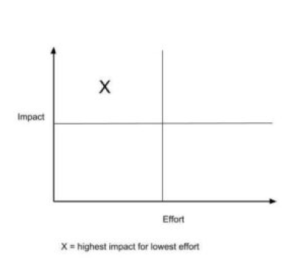Impact and Effort Matrix (Linked to Lightning Decision Jam)
The Effort Impact Matrix is one of the tools we use all the time. In this decision-making exercise, possible actions are mapped based on two factors: effort required to implement and potential impact. So, the main goal is to generate ideas and examine them by two factors: Impact and Effort. Categorising ideas along these lines is a useful technique in decision making, as it obliges contributors to balance and evaluate suggested actions before committing to them. The impact effort matrix is also referred to as an action priority matrix. It can be applied to anything, from simple tasks to complex projects, by anyone, from single individuals to large organisations.
- Type: decision making, ideation, prioritise
Practitioners:
This activity is based on a further elaboration by JO Education’s staff of a resource curated by the partnership of the Erasmus+ Project FAVILLE. One of the aims of the project FAVILLE was that of developing a digital application containing several resources that could be used both face-to-face and online by groups of people and learners, under the direction of a learning facilitator.
Objectives:
Understanding the effects of possible actions to be taken, selecting only those ones which bring the most benefits to the organisation. It also leads to more effective decision-making processes.
Structure of the process:
The Effort Impact Matrix is a simple yet powerful tool for having a group conversation to make clear what all your priorities should be. It’s an exercise you can do with your teams that’ll helpyou all work out what you should be working on.
The reason for doing it? Just because you explained the priorities and it was really clear
in your head, doesn’t mean that it’s really clear in everyone else’s head. People always hear different stuff to what you think you’ve said. If you do the Effort Impact exercise with your group or team, you’ll all get clearer, and it might shed light on what everyone is working on right now too.
The four sections of the matrix are:
> QUICK WINS (high impact, low effort): These are the most attractive ideas/projects, giving you a good return for relatively little effort.
> MAJOR PROJECTS (high impact, high effort): While these give good returns, they take along time to complete and can be complex to execute.
> WAIT (low impact, low effort): Don’t worry too much about doing these – if you’ve got spare time, do them.
> DON’T DO (low impact, high effort): Avoid these. Not only do they give low returns, they crowd out time which would be better used elsewhere.
Steps:
Prepare Effort-Impact matrix – a grid with four quadrants based on the overlap between effort and impact. Impact runs along the side y axis. The higher up, the more impact. Effort runs along the bottom x axis. The further to the right along this axis, the harder
the task or project (see the picture below).
Impact:
The potential payoff of the action
Effort:
The cost of taking the action

Explain the section of the 2×2 matrix to all participants and then divide the group into subgroups of max 5 persons, or if the group is smaller the participants might work individually. Share the picture of 2×2 matrix with each group.
To open the exercise, frame the goal in terms of a “What to do” or “What we need” question. This may sound as simple as “What do we need to reach our goal?” Given a goal, a subgroup may have a number of ideas for how to achieve it.
Turn on breakout rooms in the chosen tool for the online cooperation (Zoom..) so each subgroup can work separately, ask them to generate ideas individually and write these in their 2×2 matrix.
Then ask each subgroup to present/write their ideas back to the group by placing/writing them within an empty 2×2 matrix which you have prepared for the whole group. In a virtual environment, each subgroup should use a different colour while writing & presenting their inputs.
As participants place their ideas into the matrix, the group may openly discuss the position of elements. It is not uncommon for an idea to be bolstered by the group and to move up in potential impact or down in effort. In this respect, the category of high impact, low effort will often hold the set of ideas that the group is most agreed upon and committed to.
Your Approach:
As a leader of the activity you should let the participants self-regulate as much as possible,
but you have to take action if someone is not being able to express their position or if, on the contrary, someone is doing it more than once.
Remarks
The activity works best when the participants choose their order of “play”.
Source/Acknowledgments:
Written by: Facilitators of Virtual Learning (FAVILLE)’s partnership, JO Education, Italy
Keywords
- Timeframe: 15-60 minutes
- Entrecomp Competencies: Valuing ideas, Self-awareness & self-efficacy, Working with others, Learning through experience, Planning & management
- Fields/Needs: Issue analysis, Goal setting, Project management, Evaluation
- Online: Yes, but with adaptations
- Age group: 15+
- Number of participants: 6-15 people
- Who can play: Everyone

